How to Cook Swordfish Nuggets Recipes ?
Swordfish nuggets are a delectable and healthy option for seafood lovers, offering a lean protein-packed meal with a satisfying crunch. This recipe is perfect for both beginner and seasoned home cooks alike, providing versatility and simplicity in its preparation. The tangy zing of lemon juice and the smooth richness of olive oil combine with swordfish’s firm texture to create an irresistible dish that can be served as an appetizer, snack, or main course. Whether you’re looking to impress guests at a dinner party, create a light meal for lunch, or indulge in a high-protein snack, swordfish nuggets are a must-try.
In this extensive guide, we will explore everything from the necessary tools and ingredients to flavor variations, serving suggestions, and expert tips. By the end of this article, you’ll have all the knowledge you need to prepare swordfish nuggets like a pro. Plus, for those looking for gluten-free, keto, or vegan options, we’ve got you covered with substitution ideas and dietary adjustments. This recipe is also ideal for health-conscious individuals, offering a rich source of omega-3 fatty acids and vitamins.
If you’re a fan of light, quick meals, don’t forget to explore our Lunch and Snacks sections for more ideas that fit your healthy eating goals!
Ingredients Overview: Fresh and Flavorful Ingredients for Swordfish Nuggets
Key Ingredients for Swordfish Nuggets:
When cooking swordfish nuggets, high-quality ingredients are essential for maximizing flavor and texture. Each component in this recipe has been carefully selected to ensure balance, so make sure to follow the ingredient list for the best results.
- Swordfish Fillets: Swordfish is known for its meaty, firm texture, which makes it ideal for frying or baking. Fresh swordfish is preferable, but frozen fillets can also be used. Just be sure to thaw them completely and pat them dry before cooking. Cut the swordfish into bite-sized chunks to make perfect nuggets.
- Olive Oil: This heart-healthy oil adds depth to the flavor of the swordfish. Choose extra virgin olive oil for the best quality and richness. If you need an alternative, avocado oil or coconut oil can also be used, though they will alter the flavor profile slightly.
- Lemon Juice: The brightness of fresh lemon juice enhances the flavor of the swordfish while balancing the oil’s richness. The acidity of the lemon also helps to tenderize the fish, making it even more succulent. Lime juice can be used as a substitute if you want to experiment with different citrusy notes.
- Garlic Powder: This ingredient adds an aromatic touch to the marinade without overpowering the natural flavor of the swordfish. If you prefer a more intense garlic flavor, you can substitute garlic powder with freshly minced garlic. Keep in mind that fresh garlic will impart a sharper bite, so use it sparingly.
- Breadcrumbs: For a crisp coating, breadcrumbs are essential. Panko breadcrumbs are highly recommended because they yield a light and crunchy texture, but regular breadcrumbs work just as well. To make this dish gluten-free, simply substitute the breadcrumbs with a gluten-free variety or crushed gluten-free crackers.
- Salt and Pepper: No savory dish is complete without the proper seasoning of salt and pepper. Be generous but mindful when adding these to ensure the swordfish nuggets are well-seasoned. If you’re feeling adventurous, you can also experiment with flavored salts like smoked salt or lemon pepper.
- Paprika: Though optional, paprika adds a lovely color and subtle smokiness to the swordfish nuggets. For those who prefer a bit more heat, smoked paprika or cayenne pepper can be added for an extra kick.
By using fresh, high-quality ingredients, you’ll ensure that your swordfish nuggets come out flavorful and delicious every time. Want more light meal ideas that fit into your healthy eating plan? Be sure to check out our Snacks section for similar recipes!
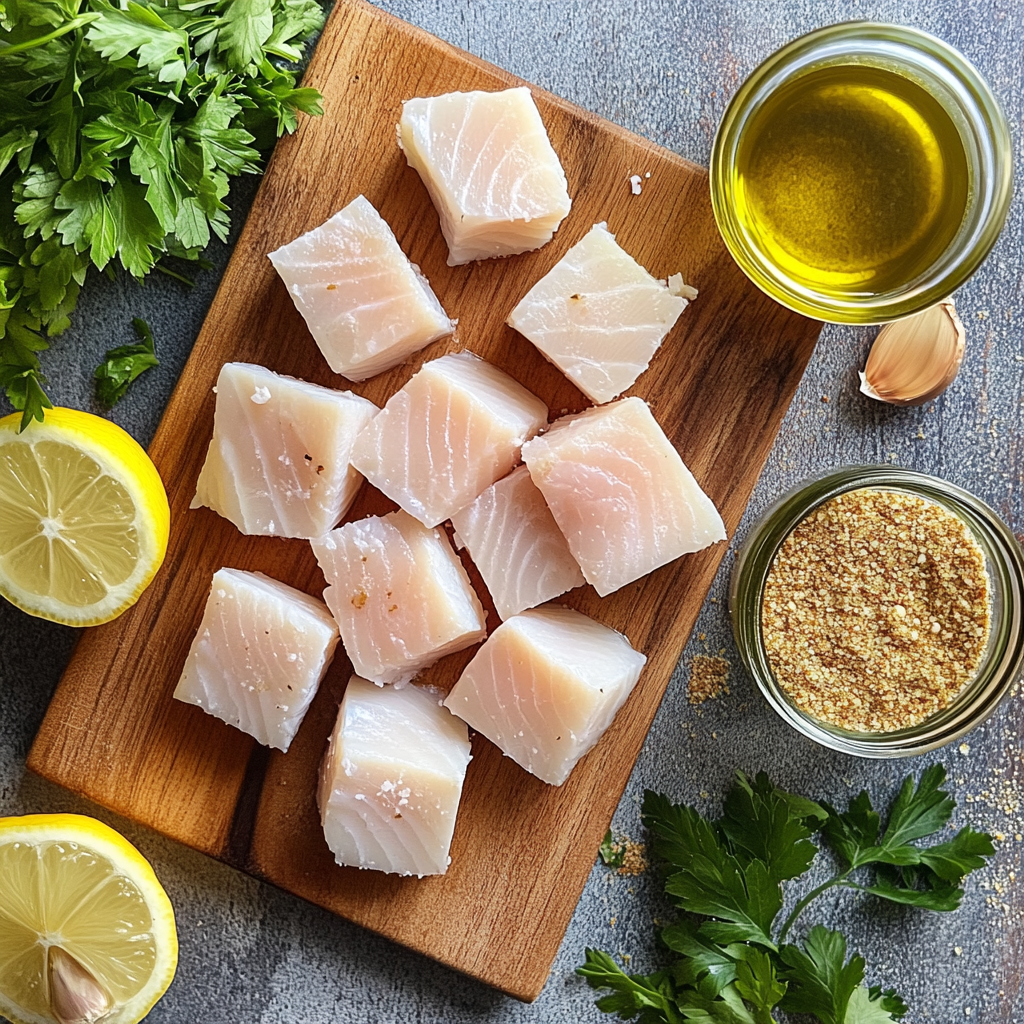
Tools Needed: Kitchen Essentials for Cooking Swordfish Nuggets
You don’t need a high-end kitchen or advanced tools to make swordfish nuggets, but having the right equipment will make the process smoother and more efficient. Below is a list of essential tools, along with alternatives in case you don’t have every item in your kitchen.
Essential Tools:
- Cutting Board: A sturdy cutting board is a must when working with swordfish. Opt for a wooden or plastic cutting board, which provides a stable surface for slicing through the firm texture of swordfish. You’ll need it for cutting the fillets into nugget-sized pieces.
- Sharp Chef’s Knife: A high-quality, sharp chef’s knife is crucial for ensuring clean cuts. Swordfish has a dense texture, so a dull knife might tear the fish rather than slice it. If you don’t have a chef’s knife, a well-sharpened utility knife will work in a pinch.
- Mixing Bowls: You’ll need a few bowls for marinating the fish and coating the nuggets. Stainless steel, glass, or ceramic bowls are ideal for mixing the marinade and preparing the breadcrumb coating.
- Tongs: Tongs make it easier to handle the swordfish nuggets during frying or baking, allowing you to flip them without breaking the coating. If you don’t have tongs, a spatula or slotted spoon can be used as an alternative.
- Non-stick Pan: A non-stick pan is key to frying swordfish nuggets without having them stick to the bottom. If you prefer a crispier texture, use a cast iron skillet, which retains heat and promotes even browning.
- Baking Tray: If you prefer baking your swordfish nuggets instead of pan-frying them, you’ll need a baking tray lined with parchment paper or foil. This method is great for those looking to cut down on oil.
For those interested in recipes that require similar tools, feel free to explore our Dinner section, where you’ll find a variety of dishes that use a non-stick pan and cast iron skillet.
Step-by-Step Instructions: How to Cook Swordfish Nuggets to Perfection
The preparation of swordfish nuggets is both simple and rewarding. By following these clear, step-by-step instructions, you’ll have a delicious and healthy meal ready in no time. Whether you’re new to cooking or a seasoned chef, this recipe is easy to follow and yields great results.
Step 1: Marinate the Swordfish
The first step is to marinate the swordfish to infuse it with flavor and ensure that it remains tender during cooking. In a mixing bowl, combine the following:
- 3 tablespoons of olive oil
- 2 tablespoons of fresh lemon juice
- 1 teaspoon of garlic powder
- Salt and pepper to taste
Cut the swordfish fillets into nugget-sized pieces, about 1 to 2 inches in size, and toss them into the marinade. Ensure that each piece is well-coated. Cover the bowl with plastic wrap and refrigerate for at least 20 minutes, or up to an hour for a more intense flavor. The acidity from the lemon juice will help to tenderize the fish while adding a fresh, zesty note.
Step 2: Prepare the Coating
While the fish is marinating, prepare the coating that will give the nuggets their crispy texture. In a shallow bowl, combine:
- 1 cup of breadcrumbs (or panko for extra crunch)
- 1 teaspoon of paprika
- Salt and pepper to taste
If you’re looking for a gluten-free alternative, swap out the breadcrumbs for crushed gluten-free crackers or almond flour for a low-carb option. Set this mixture aside until the fish has finished marinating.
Step 3: Coat the Nuggets
After the swordfish has marinated, take each nugget and press it firmly into the breadcrumb mixture. Make sure each piece is thoroughly coated on all sides, as this will help create that irresistible crunch once fried or baked.
Step 4: Fry or Bake the Swordfish Nuggets
Option 1: Pan-frying
Heat 2-3 tablespoons of olive oil in a non-stick pan over medium heat. Once the oil is hot, carefully place the breaded swordfish nuggets in the pan. Make sure not to overcrowd the pan—cook in batches if necessary. Fry the nuggets for about 3-4 minutes per side, or until golden brown and crispy. The total cooking time should be about 8-10 minutes, depending on the size of your nuggets.
Option 2: Baking
For a healthier version, preheat your oven to 400°F (200°C). Line a baking tray with parchment paper or foil, and place the breaded swordfish nuggets on the tray. Drizzle a little olive oil over the top to promote browning. Bake for 12-15 minutes, flipping halfway through, until the nuggets are golden and crispy. Baking allows you to use less oil, but the nuggets will still come out deliciously crunchy.
For more cooking techniques that utilize pan-frying, check out our Breakfast section for quick and easy recipes that focus on the art of pan-cooking.
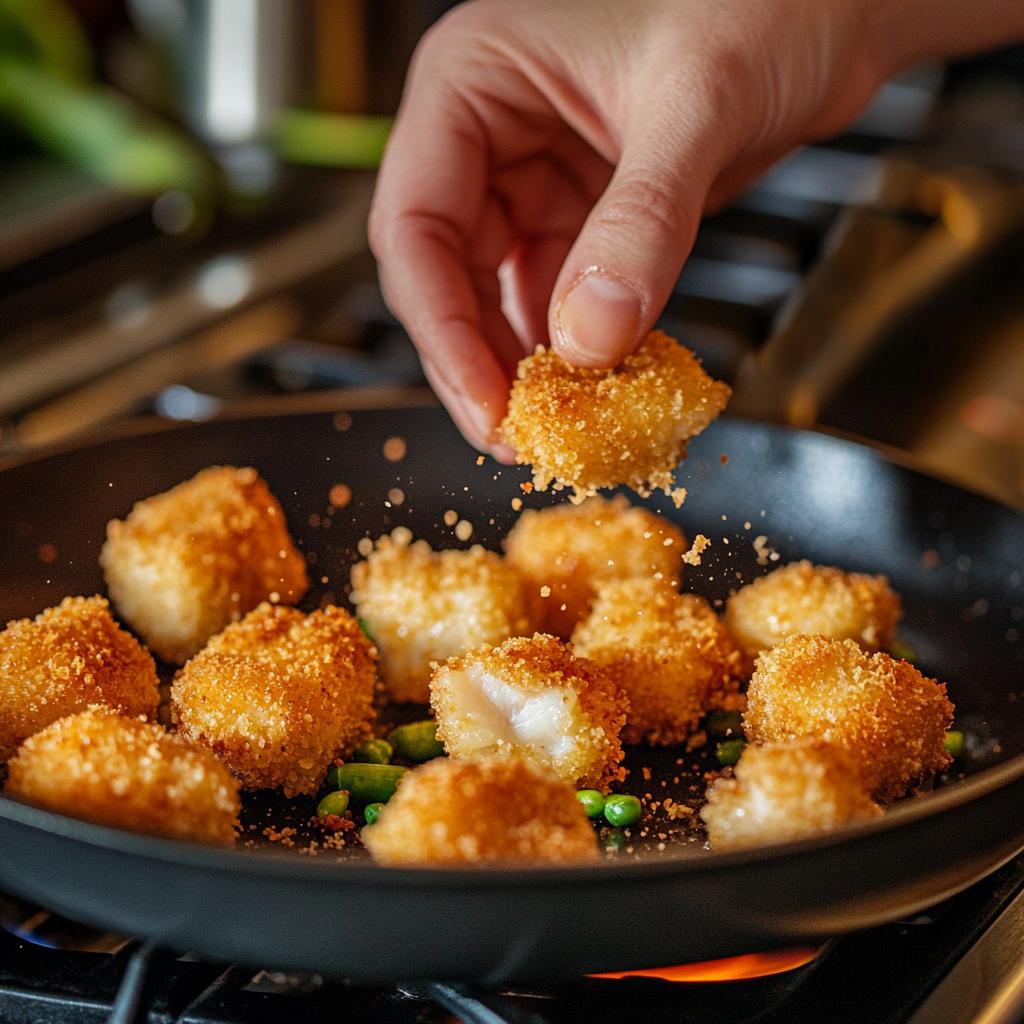
Flavor Variations: Customize Your Swordfish Nuggets
One of the best aspects of swordfish nuggets is how versatile they are. With a few simple tweaks, you can change the flavor profile to suit your tastes or dietary requirements. Below are some delicious variations you can try:
- Herbed Lemon Swordfish Nuggets: Add fresh herbs like chopped parsley, dill, or thyme to the marinade. These herbs will give the nuggets a light, aromatic flavor, perfect for serving with a green salad.
- Spicy Cajun Swordfish Nuggets: Swap out the paprika for Cajun seasoning or smoked paprika to give your nuggets a spicy, smoky twist. Serve with a side of cooling yogurt or a creamy dipping sauce to balance the heat.
- Vegan Version: If you’re following a vegan diet, you can easily adapt this recipe by replacing the swordfish with firm tofu or cauliflower florets. Tofu mimics the meaty texture of swordfish when breaded and fried, while cauliflower offers a lighter, vegetable-based alternative.
- Low-Carb/Keto Option: For a keto-friendly version, replace the breadcrumbs with finely ground almond flour or crushed pork rinds. These alternatives will give the nuggets a crunchy texture without the carbs, making them perfect for those on a low-carb or ketogenic diet.
These flavor variations are just the tip of the iceberg! If you’re interested in more healthy snacking ideas, check out our Snacks section for complementary recipes that pair well with swordfish nuggets.
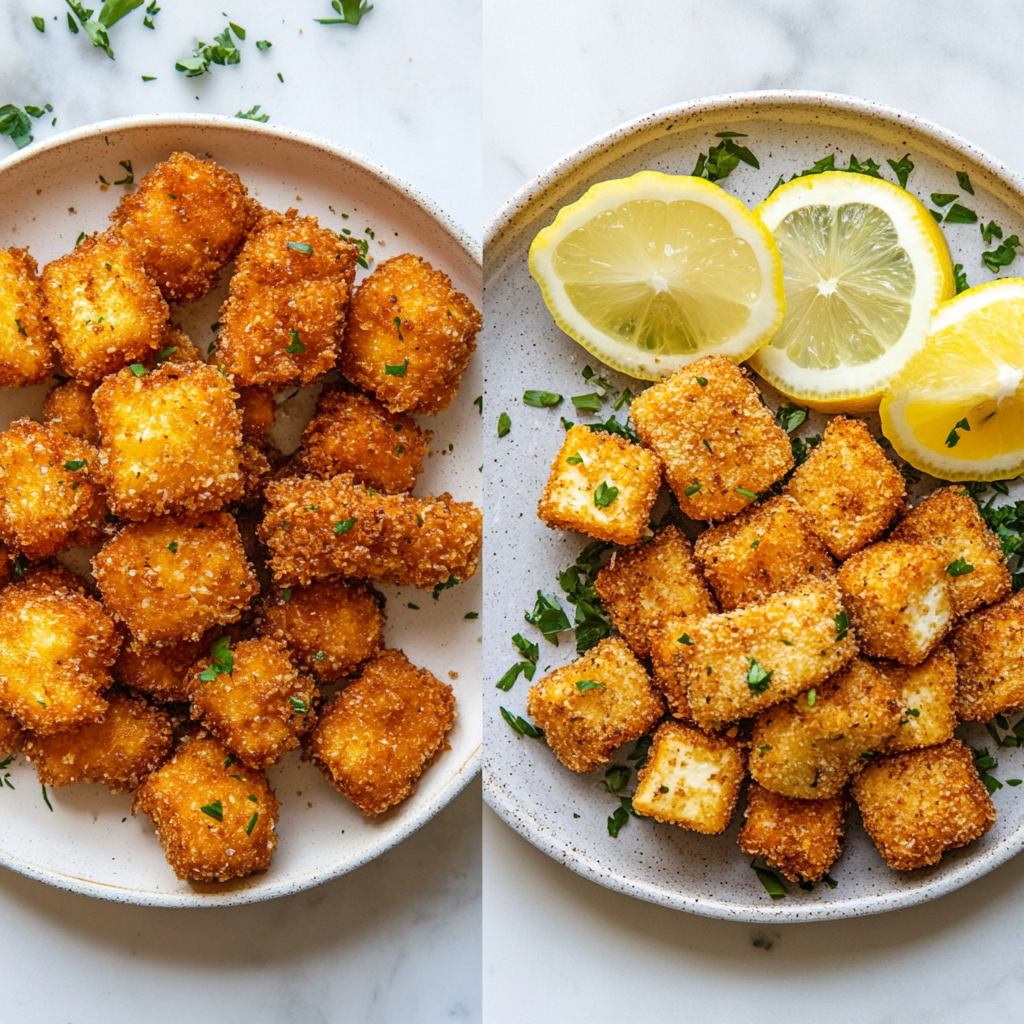
Expert Tips: How to Master Swordfish Nuggets
Even the most straightforward recipes have their tricks. Below are some expert tips to ensure that your swordfish nuggets turn out perfectly every time:
- Don’t Overcook: Swordfish is a firm, meaty fish, but it can become dry if overcooked. Keep an eye on your nuggets while frying or baking. As soon as they turn golden brown and firm to the touch, they are ready. The internal temperature should reach 145°F (63°C) for fully cooked fish.
- Marinate for Flavor: While 20 minutes of marinating will infuse the fish with flavor, letting it marinate for up to an hour will yield even better results. The lemon juice will also help tenderize the fish, making it juicy and flavorful.
- Use Fresh Swordfish: Fresh swordfish is ideal for this recipe, as it provides the best texture and flavor. However, if you only have access to frozen swordfish, make sure to thaw it completely in the fridge and pat it dry with paper towels to remove excess moisture before marinating.
- For Extra Crunch, Double Dip: For an even crunchier coating, you can double-dip the swordfish nuggets. After the first breadcrumb coating, dip them back into the marinade and coat them with breadcrumbs again. This will give you an extra layer of crispiness.
- Pair with Dips: While swordfish nuggets are flavorful on their own, a dipping sauce can elevate them even further. Try serving them with tartar sauce, a garlic aioli, or a tangy lemon yogurt sauce for added zest.
For more professional cooking techniques and tips, explore our Dinner section, where we share advice on how to perfect a variety of seafood and meat dishes.
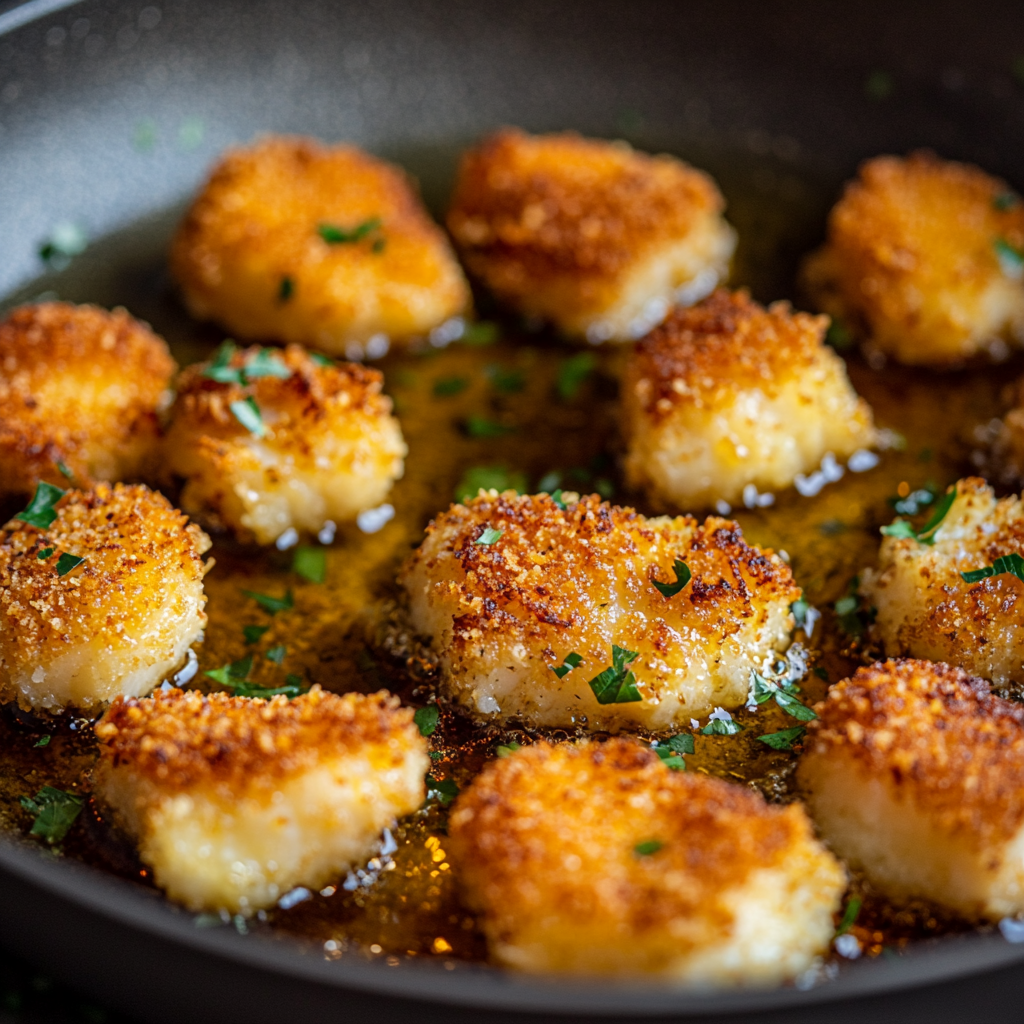
Nutritional Information: Health Benefits of Swordfish Nuggets
Swordfish is a nutrient-dense fish, offering several health benefits. In this section, we’ll break down the nutritional content of swordfish nuggets and discuss why this dish can be a healthy addition to your diet.
Estimated Nutritional Breakdown per Serving (4-6 nuggets):
- Calories: 350-400 per serving (depending on the amount of oil used for frying)
- Protein: 25-30 grams per serving, making this an excellent high-protein meal option.
- Fat: 15-18 grams, most of which comes from heart-healthy olive oil and omega-3 fatty acids found in the swordfish.
- Carbohydrates: 15 grams, primarily from the breadcrumb coating. For those on a low-carb or keto diet, this can be reduced by using almond flour or pork rinds instead of breadcrumbs.
- Omega-3 Fatty Acids: Swordfish is rich in omega-3 fatty acids, which are known to support heart health and reduce inflammation.
- Vitamins and Minerals: Swordfish is an excellent source of vitamin D, vitamin B12, selenium, and phosphorus, all of which contribute to overall health, from boosting energy levels to supporting strong bones.
For a more in-depth look at the health benefits of swordfish and its nutritional profile, refer to the authoritative article from I Healthline, which offers a comprehensive breakdown of swordfish as a nutrient-rich protein source.
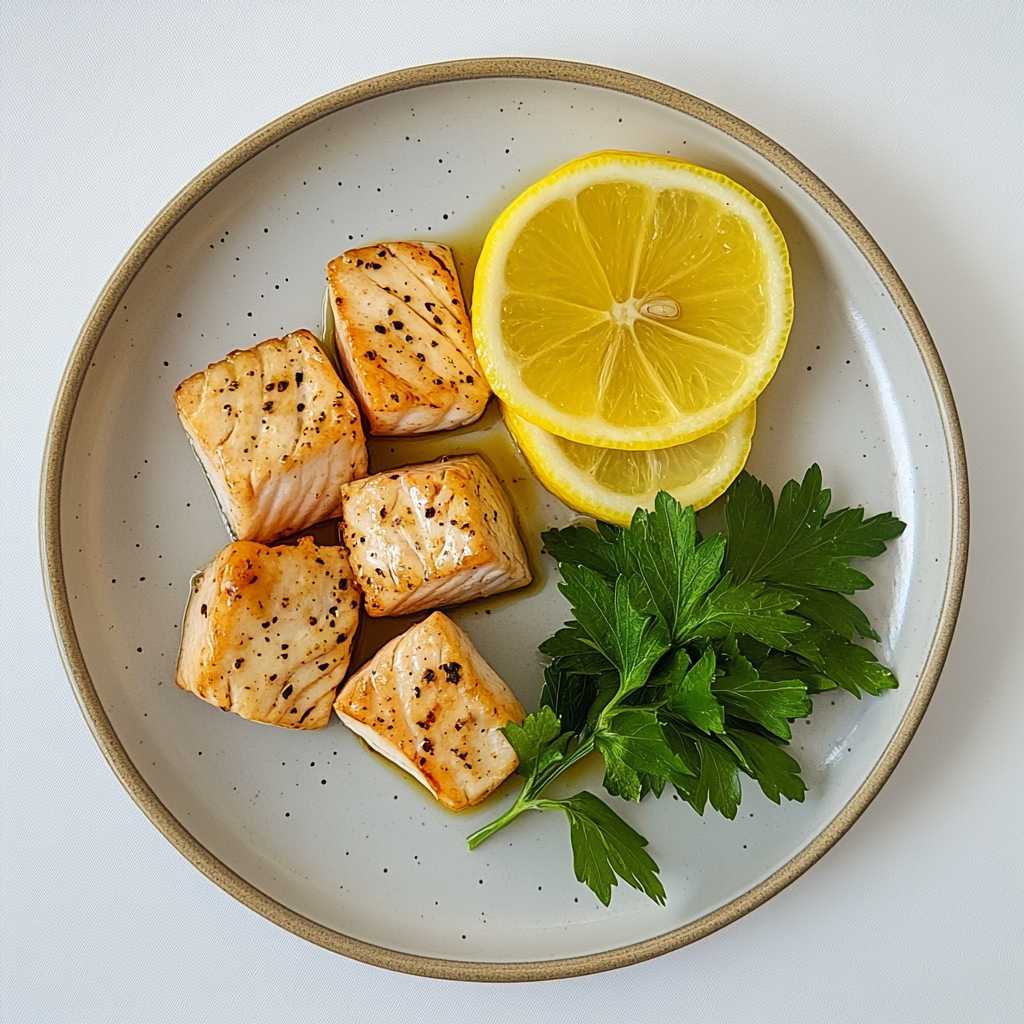
Serving Suggestions: How to Serve Swordfish Nuggets
Swordfish nuggets are versatile and can be served with a variety of sides, sauces, and garnishes to create a complete and satisfying meal. Here are some serving suggestions to help you elevate your dish:
- With a Green Salad: Pair the crispy nuggets with a refreshing green salad of arugula, baby spinach, or mixed greens. Toss the salad with a light lemon vinaigrette to complement the lemony flavor of the swordfish.
- With Tartar Sauce: A classic tartar sauce made from mayonnaise, pickles, capers, and a squeeze of lemon juice is the perfect accompaniment for swordfish nuggets. The creaminess of the sauce contrasts beautifully with the crunchy exterior of the nuggets.
- Grilled Vegetables: Swordfish nuggets pair well with grilled vegetables such as zucchini, bell peppers, and asparagus. Lightly season the vegetables with olive oil, salt, and pepper, and grill them until they’re tender and slightly charred.
- With Rice Pilaf: A simple yet flavorful rice pilaf made with garlic, onions, and a squeeze of lemon juice is a perfect side for swordfish nuggets. The rice will soak up any leftover juices from the nuggets, making it a delicious and hearty side.
- With a Dipping Sauce Trio: Serve the nuggets with a trio of dipping sauces: garlic aioli, lemon yogurt sauce, and a spicy sriracha mayo. This will give your guests or family members the option to mix and match their flavors.
For more serving ideas that can be paired with swordfish nuggets, head over to our Dinner section, where we share a variety of sides and accompaniments for seafood dishes.
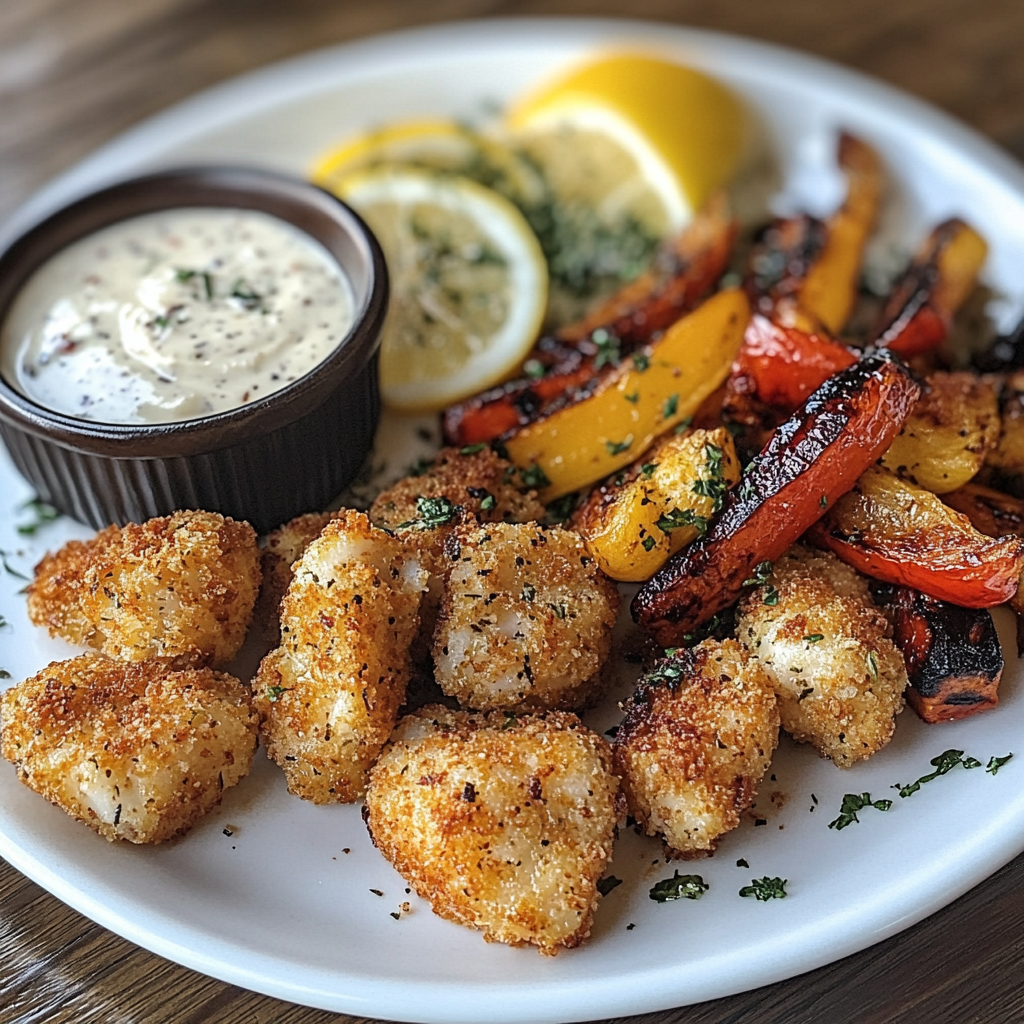
Storage Tips: How to Store and Reheat Swordfish Nuggets
Swordfish nuggets are best eaten fresh, but if you have leftovers or want to make them ahead of time, here are some tips on how to store and reheat them properly.
Refrigerating Leftovers
If you plan on eating the leftovers within the next couple of days, store them in an airtight container and refrigerate. They will keep for up to 2 days in the fridge.
Freezing Swordfish Nuggets
Swordfish nuggets can also be frozen for longer storage. To freeze them, place the cooked nuggets in a single layer on a baking sheet and freeze for about 1-2 hours. Once frozen, transfer them to a freezer-safe bag or container. They will last for up to 2 months in the freezer. This method prevents the nuggets from sticking together and makes reheating easier.
Reheating Tips
When reheating swordfish nuggets, it’s important to maintain their crispy texture. The best way to reheat them is in the oven. Preheat your oven to 375°F (190°C), place the nuggets on a baking sheet, and heat for 10-15 minutes or until warmed through and crispy. Avoid microwaving, as this can make the nuggets soggy.
FAQs: Common Questions About Cooking Swordfish Nuggets
Can I use other types of fish for this recipe?
Yes! While swordfish is ideal due to its firm texture, other types of fish like tuna, halibut, or cod can also work well in this recipe. Just keep in mind that different fish may require slight adjustments to cooking time.
How can I make swordfish nuggets gluten-free?
To make this recipe gluten-free, simply swap out the breadcrumbs for gluten-free breadcrumbs, crushed gluten-free crackers, or even ground almonds for a low-carb option. You can also omit the breading altogether for a lighter version of the dish.
Is it better to fry or bake swordfish nuggets?
Both methods work well, but frying will give you a crispier exterior, while baking is a healthier alternative. If you’re counting calories or prefer to use less oil, baking is the way to go. For a compromise, you can lightly fry the nuggets and then finish them off in the oven for extra crispiness.
Can I make swordfish nuggets ahead of time?
Yes, you can make swordfish nuggets ahead of time and store them in the fridge or freezer. Follow the storage tips above for best results. To maintain their crispy texture, reheat them in the oven rather than the microwave.
For more answers to common cooking questions, visit our Dinner section, where we address frequently asked questions and offer expert advice on a wide range of recipes.
Conclusion: The Versatility and Ease of Swordfish Nuggets
Swordfish nuggets are a delicious, healthy, and versatile dish that can easily become a staple in your home. Whether you’re serving them as an appetizer at a dinner party, preparing them as a quick lunch, or freezing them for a meal-prep option, they’re sure to impress. The combination of lemon juice, olive oil, and a perfectly crisp coating creates a dish that is both flavorful and satisfying.
